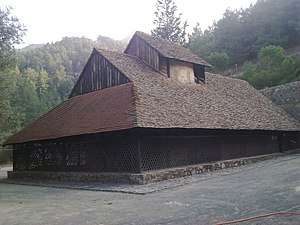Panagia tou Araka
The Panagia tou Araka or Arakos (Greek: Παναγία του Άρακα or Άρακος) is a middle Byzantine Orthodox church located in Cyprus. It stands as one of the most well known and completely preserved middle Byzantine churches with mural paintings.[1]

History
The church is located by the village of Lagoudera, Cyprus. Similar to other churches in the area, this church was named after a wildflower, the vetch. It was built atop the northeast slopes of Madari, the second highest summit of the Troodos Mountains. The date and circumstances of the church's consecration remain uncertain, but with its location between the villages of Lagoudera and Sarandi, it is postulated that the church was owned privately or that it was a monastery since it was situated away from the villages.[2]
Most of the church's history is recorded within its mural paintings. From the inscription of the interior north lintel, it was stated that they were completed in December 1192,[1] and were painted by a Constantinopolitan-trained monk named Theodore Apsevdis. Apsevdis's work could have possibly been commissioned by a Byzantine aristocrat named Leontios Authentes, who was seeking refuge at a nearby monastery built by his father. Around the 14th century, the mural paintings were restored due to water damage and the inscription for these restorations were signed by a deacon named Leontios.[3]
Mural Paintings
Virgin of the Passion

This mural was the first of its kind in Komnenian-period art, during the reign of Alexios I Komnenos (r. 1081–1118), and it was painted in 1192 under the patronage of Leontios Authentes by Theodore Apsevdis on the southeastern wall of the church. Imagery of the Virgin has always been associated with political strength within the Byzantine Empire; however, this particular painting does not hold the same symbolic meaning.[3] Just prior to its conception, the island of Cyprus went through bouts of battles and changes in leadership. This period of turmoil and chaos is reflected in the image depicting the Virgin of the Passion. As stated by the historian Sophocleous:
"The donor's grief is perceived through the transformation of the Virgin's image which he prescribes."[4]
This grief is presented in the way that this version differs from the other depictions of the Virgin of Passions. This painting depicts Mary in full length, standing in front of her throne, holding the Christ child as opposed to other depictions of her from the shoulders up. Additionally, the angels bearing the spear and the cross (a reference to Christ's future) are as large as Jesus whereas other versions of this icon, the angels are small and indiscernible to the composition. This emphasis on the angels carrying symbols of Christ's passion and the depiction of the Virgin standing holding her child, could be interpreted as the Virgin handing her child to His fate, just as she is offering up the island of Cyprus to many of its volatile leaders.[3] Accompanying the painting is an elaborate prayer to the Virgin which also helps indicate the patron for this particular mural painting.
"All-pure mother of God, he who has portrayed
your immaculate image in perishable colors
with great yearning and most ardent faith,
Leon, your poor and worthless servant,
called after his father Authentes,
together with his consort and fellow servant [name of wife] request faithfully with countless tears
to find a happy conclusion to the rest of their life
together with their fellow slaves and children, your servants, and receive the death of the saved.
For you alone, Virgin, are able to be glorified.
When entreated to provide people with"[3]
Saint Simeon and Saint John the Baptist
Across from the Virgin of Passion is the mural painting of Saint Simeon, holding Christ child with Saint John the Baptist standing next to him. The placement of this painting has implication of the Presentation in the Temple scene in the New Testament. According to Luke 2.22-29, the elder Symeon rushed to see the Christ child as it was prophesied that he would not die until he saw the "Anointed of the Lord." Additionally, the presence of St. John the Baptist carries significant meaning in suggesting the fate of Christ and his sacrifice. This foreshadowing of Christ's future is written in the scroll held by St. John the Baptist stating:
"Behold the Lamb of God who takes away the sins of the world."
Also, the positioning of this painting could also refer to the purification rituals that was performed on the Virgin as was the custom for the mother to be purified in a temple forty days after the birth of the first born son.[5]
Preservation and conservation
The preservation of the mural paintings within this church was sponsored by Dumbarton Oaks Research Center and Collection. David and June Winfield oversaw the preservation project from 1968 until 1973. Within those years, the Winfields wrote detailed reports of their process in restoring the mural paintings for Dumbarton Oaks.[2] Within these reports, they would describe such things as the differences in brushwork and usage of colors between Theodore Apsevdis and the deacon Leontios. They also made note of the materials used (ultramarine, vermilion, gold leaf and silver), these ingredients could be found locally in the valley.[1]
References
- Carr, Annemarie Weyl. Speculum 80, no. 3 (2005): 999-1001.
- Winfield, David C.; Mango, Cyril (1969–1970). "The Church of the Panaghia Tou Arakos at Lagoudhera: First Preliminary Report". Dumbarton Oaks. 23-24: 377–380.CS1 maint: date format (link)
- Milliner, Matthew John. “The Virgin of the Passion: Development, dissemination and afterlife of a Byzantine icon type.” ProQuest Dissertations Publishings. Princeton University. (2011).
- Sophocleous, Sophocles (1998). Panagia Arakiotissa Lagoudera Cyprus. Museum Publications. p. 47. ISBN 9963782124.
- Baltoyianni, Chrysanthe. "Christ the Lamb and the ἐνώτιον of the Law in a Wall Painting of Araka on Cyprus." Δελτίον Χριστιανικής Αρχαιολογικής Εταιρείας 17 (1993): 53-58.